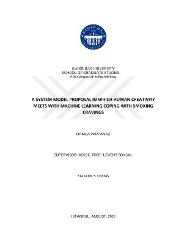| dc.contributor.advisor | Soysal, Levent | en_US |
| dc.contributor.author | Partanaz, Damla | |
| dc.date.accessioned | 2020-02-17T19:02:34Z | |
| dc.date.available | 2020-02-17T19:02:34Z | |
| dc.date.issued | 2019 | |
| dc.identifier.uri | https://hdl.handle.net/20.500.12469/2770 | |
| dc.description.abstract | Quitting smoking is hard, yet preventing relapse can be even harder. During those craving moments, urges to smoke may be the determining factor as to whether a smoking quitter will relapse or not. I researched the question "what could be done at craving moments in order to resist to smoke?" and spotted that the things that can be done/thought, at the craving moments instead of smoking, can vary from person to person and even from one craving moment to another craving moment. So I figured out that some people can come up with "instant creative solutions with some design thinking approach to these craving moments". Actually, people are already doing this even if some of them are doing this unconsciously and do not look at those acts as "solutions". And if they do, those solutions -real world information- are not preserved as computable data. Thereupon I pursued the question: "how can I computerize these experiences and enable the exchange of those solutions between smoking quitters in an optimum way?". Drawing inspiration from this question I designed a system model. The designed system will (1) take solutions from smoking quitters for each craving moment they encounter and pass without smoking, and (2) give the optimum solution from collected solutions to the ones who need a solution at their craving moment. These solutions are on the edge of the smoking quitters' imagination and creativity. And the given instant solution- the recommendation- will be (1) personalized and also (2) suitable with that craving moment's characteristic 'features'. These solutions can vary just as the answers to these questions (a) "where?", (b) "while doing what?", (c) "with whom?", (d) "which emotion state?", and (e)"when?". I researched two topics: smoking cravings, machine learning. Then to better understand the users, I conducted a qualitative exploratory approach and in-depth interviews. In the light of the analysis of these interviews, I designed the conceptual model of the system model and lastly for the system-user interface design and as a data collection solution I designed and developed a chatbot named "Drop-it-at-t0_bot" on Telegram. | en_US |
| dc.description.abstract | Sigarayı bırakmak zordur, ancak tekrar başlamayı önlemek daha da zor olabilir.
Aşerme anları, sigara içme dürtüsü, sigarayı bırakmış bir kişinin sigaraya tekrar
başlayıp başlamayacağı konusunda belirleyici olabilir. “Sigara içmemek için aşerme
anlarında neler yapılabilir?” sorusunu araştırdım ve sigara içmek yerine aşerme
anlarında yapılabilecek / düşünülebilecek şeylerin kişiden kişiye ve hatta bir aşerme
anından bir aşerme anına farklı olabileceğini farkettim. Ve bazı insanların “bu aşerme
anlarına tasarımsal düşünme yaklaşımıyla anlık yaratıcı çözümler” bulabileceklerini
anladım. Aslında, bunu zaten yapıyorlar. Ancak bazıları bunu bilinçsizce yapıyor ve
bu eylemlere “çözüm” olarak bakmıyorlar. Ayrıca öyle baksalar bile, bu çözümler
hesaplanabilir takip edilebilen veriler değillerdir. Bunun üzerine şu soruyu sordum:
“Sigarayı bırakmış kişiler arasında bu deneyimlerini/çözümlerini optimum şekilde
nasıl sirküle edebilirim?”. Sonra bir sistem modeli tasarladım. Tasarlanan sistem (1)
karşılaştıkları ve sigara içmeden geçirdikleri her aşerme anı için kişilerin
buldukları/uyguladıkları çözümleri alacak ve (2) toplanan çözümlerden aşerme anında
çözüme ihtiyaç duyanlara en uygun çözüm sunacaktır. Bu çözümler sigarayı
bırakanların hayal gücü ve yaratıcılığının sınırındadır. Ve verilen öneri (1)
kişiselleştirilmiş ve ayrıca (2) kişinin içinde bulunduğu aşerme anının özelliklerine
uygun olacaktır. Bunlar, (a) “nerede?”, (b) “ne yaparken?”, (c) “kiminle?”, (d) “hangi
duygu durumunu?” ve (e) "ne zaman?” sorularının cevapları olabilir. İki konuyu
araştırdım: sigara aşermeleri ve makine öğrenmesi. Sonra kullanıcıları daha iyi
anlamak için, nitel bir keşif yaklaşımı ve derinlemesine görüşmeler yaptım. Bu
görüşmelerin analizleri ışığında, sistem modelinin kavramsal modelini ve hem veri
toplama çözümü hem de kullanıcı-sistem arayüzü çözümü olarak bir chatbot tasarladım
ve geliştirdim. | en_US |
| dc.language.iso | eng | en_US |
| dc.publisher | Kadir Has Üniversitesi | en_US |
| dc.rights | info:eu-repo/semantics/openAccess | en_US |
| dc.subject | Smoking cravings | en_US |
| dc.subject | Human-Machine collaboration | en_US |
| dc.subject | machine learning | en_US |
| dc.subject | system design | en_US |
| dc.subject | chatbot | en_US |
| dc.subject | design thinking | en_US |
| dc.subject | computational thinking | en_US |
| dc.subject | data collection | en_US |
| dc.subject | Sigara aşermesi | en_US |
| dc.subject | İnsan-Makine işbirliği | en_US |
| dc.subject | makine öğrenmesi | en_US |
| dc.subject | sistem tasarımı | en_US |
| dc.subject | chatbot | en_US |
| dc.subject | tasarım düşüncesi | en_US |
| dc.subject | hesaplamalı düşünme | en_US |
| dc.subject | veri toplama | en_US |
| dc.title | A system model proposal in which human creativity meets with machine learning coping with smoking cravings | en_US |
| dc.type | masterThesis | en_US |
| dc.department | Enstitüler, Lisansüstü Eğitim Enstitüsü, İletişim Bilimleri Ana Bilim Dalı | en_US |
| dc.relation.publicationcategory | Tez | en_US |
| dc.identifier.yoktezid | 588556 | en_US |
















